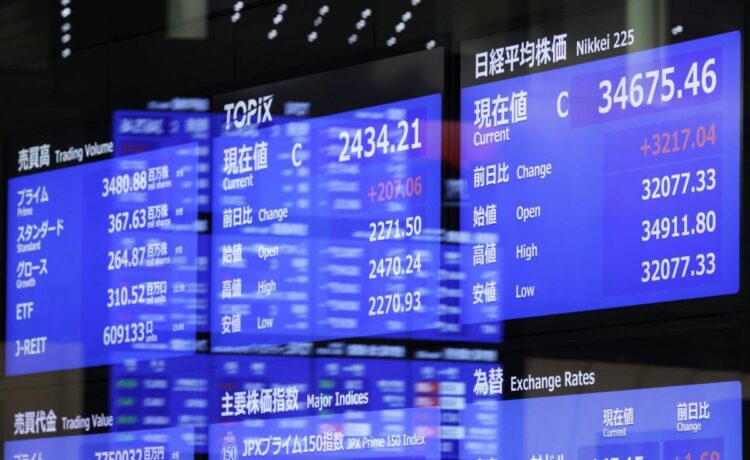(Bloomberg) — Stocks stabilized after an in-line inflation report did little to alter bets the Federal Reserve will start cutting interest rates next month.
Most Read from Bloomberg
Equities saw small moves after the S&P 500 notched its best four-day performance in 2024. Treasuries were mixed, with two-year yields up mildly while those on 30-year bonds oushing lower. Swap traders slightly trimmed bets on September Fed reduction to around 35 basis points.
The so-called core consumer price index — which excludes food and energy costs — increased 3.2% in July from a year ago, still the slowest pace since early 2021. The monthly measure rose 0.2%, a slight pickup from June’s surprisingly low reading, Bureau of Labor Statistics figures showed Wednesday.
“It may not have been as cool as yesterday’s PPI, but today’s as-expected CPI likely will not rock the boat,” said Chris Larkin at E*Trade from Morgan Stanley. “Now the primary question is whether the Fed will cut rates by 25 or 50 basis points next month. If most of the data over the next five weeks points to a slowing economy, the Fed may cut more aggressively.”
The S&P 500 hovered near 5,435. Treasury 10-year yields advanced one basis point to 3.85%.
Wall Street’s Reaction to CPI:
CPI & PPI both came in at or slightly below expectations which should continue to fuel the fire for the first rate cut in September with the largest remaining question being will it be 25bps or 50bps. Obviously, we are not back to the Fed’s targeted inflation rate but as the consumer really begins to show signs of weakness here the fire under their feet continues to get hotter. The unemployment rate moving back above 4%, which should move down in the next reading given the impact of the hurricane in Texas, will also serve as another data point to support a cut.
With today’s CPI print very much in line with consensus expectations, this report supports the disinflation trend and a Fed that will be willing to cut rates in September.
However, this CPI print does not scream out for a 50-basis point rate cut. Rather, a 25-basis point rate cut for next month is more likely.
With a renewed focus on its dual mandate, the Fed will now be more interested in the health of the economy – namely, retail sales and the initial jobless claims. Any weakness we see elsewhere in the economy would be more likely than today’s CPI print to point to a 50-basis point rate cut in September.
The Fed is going to do everything it can to avoid a policy error. That limits their willingness to cut rates aggressively in the near term.
The bottom line is that the trajectory of decelerating inflation has slowed materially, but likely remains within a comfortable range for the Fed to embark on a series of rate cuts. Now when discussing the magnitude of rate cuts in September, we still believe the labor market will be the linchpin to an outsized cut and further deterioration in the labor market increases the probability of a 50 basis point cut out of the gate.
Today’s CPI release effectively rolls out the red carpet for rate cuts to begin in September. While there is still one more CPI report to be seen before the FOMC gathers again, the July report solidified some nascent trends that will likely give them the confidence they need to pare back on tight policy. In fact, what probably matters most is the real level of fed funds; as inflation continues to fall one could argue that not paring back on rates represents de facto further tightening. That’s something the Fed will want to avoid, especially given concerns over the state of the labor market. Going forward, four rate cuts by year-end appears to be the base case, starting off a methodical normalization process for rates that’s likely to continue into 2025.
Bottom line: new data are indicating that the disinflationary trend is continuing, at the same time there are small cracks in the U.S. employment situation. The Fed should cut the fed funds rate -25bp in September, in our opinion. Nominal activity (real growth & inflation) looks to be slowing. We’re watching the Fed’s upcoming Jackson Hole symposium for any additional policy signals.
While the inflation number this morning gives the Fed the green light to cut rates at their September 18th meeting, the bond market has already rallied a great deal since the end of July with the 2yr UST down over 40 basis points. We would expect the U.S. bond market to level off at these rate levels and look for more Fed guidance as to whether the rate cut path will be slow and gentle or steeper and more drastic. This argument likely won’t be settled until the current late summer slowdown is over and everyone is back in their seats after the Labor Day holiday.
With CPI inflation at 2.9%, the Fed is getting closer to their goal. Average hourly earnings came in slightly below expectations, but this seems like a goldilocks report for the Fed. This is further evidence that consumers are re-anchoring inflation expectations in line with the Fed mandate.
Today’s CPI keeps the market on track for a potential rate cut next month. It was a little discouraging to see shelter tick back up, but the trend toward lower inflation is intact. Getting the headline number under 3% was also an important milestone.
With Federal Reserve officials increasingly noting they need more assurance that the downward trajectory of inflation remains intact, today’s CPI print, coupled with yesterday’s PPI report, should offer continued confirmation — and support— for a September rate cut.
The fear of a stagflationary environment setting in has been a continuing concern for markets, however today’s report suggests that inflation continues to edge lower at a steady pace.
Should the labor market deteriorate at a faster clip causing concern that economic conditions are contracting too rapidly, the Fed’s worries over the path of inflation should be assuaged by this week’s reports allowing them to cut rates by 25 or 50 basis points as needed, without trepidation that stagflation is setting in.
Disinflation is crystal clear in the data now. Based on the CPI data, the Fed could justify a .50 cut in September, but that’s highly unlikely.
To see a two-handle on year-over-year CPI continues to show another nice reminder that inflation is cooling and the surge we saw in the first quarter is a thing of the past. Peeling back the onion showed nice improvements in goods, including things like used cars and apparel.
The Fed’s dual mandate is price stability and full employment, which suggests the risks are tilted firmly to the latter. We aren’t sure what more the Fed needs to see to act, as the move higher in the unemployment rate lately should be in their crosshairs.
The in-line CPI threads the needle of teeing up a September rate cut without setting off alarm bells on consumption and corporate pricing power. It relieves the pressure on Jackson Hole by taking 50 basis point cuts out of the conversation and lets Wall Street go back on vacation until Labor Day.
The much-awaited Consumer Price Index (CPI) came in line with consensus this morning and it is the ultimate “No News, is Good News” report because the markets have been on edge and the Fed is looking to cut interest rates and nothing in this report should deter them from doing so.
In a not-so-subtle shift, the market has moved from worrying about inflation to worrying about economic growth and although many in the market were calling for a 50 bps rate cut next month, it’s much more likely that the Fed proceeds as planned with a 25 bps cut in September.
Today’s CPI print removes any lingering inflation obstacles that may have been preventing the Fed from starting the rate cutting cycle in September. Yet, the number also suggests limited urgency for a 50 basis point cut. With supercore inflation up from last month and a sustained deceleration in shelter inflation still elusive, a gradual reduction in policy rates may be all the Fed can provide at this time – and all that it needs to deliver. With the broad economic picture looking more mid-cycle adjustment than recession, aggressive Fed easing may not be required.
Bottom line, the pace of inflation deceleration continues but at a glacial pace. As for the Fed, I believe it will take further negative data on the labor market before the September meeting in order for them to cut 50 bps, which is very possible. Otherwise, I think It’s more likely to be 25 bps.
With the release of the PPI numbers yesterday, markets had begun to price in significant disinflation across the board, with 10-year yields declining (real rates hovering around 1.75%) and equities posting strong returns. The challenge with this report is twofold: (1) it offers little new information to guide the future decisions of the Fed, aside from potentially supporting a rate cut due to job market concerns, and (2) there is a risk that the markets may have over-anticipated its implications. Additionally, weekly earnings have declined (.4% vs. .6% last month), further signaling a cooling job market. This development could contribute to a series of data points indicating that the U.S. is currently experiencing a slowdown. By all means this is a mixed report – hard to gauge how the market will deal with it.
Headline CPI figures for July were in-line or slightly below economists’ expectations. Absent an unexpected spike in today’s inflation report, the path appears set for a September cut.
With the mostly in-line results, investors should feel more confident in a September rate cut. However, it’s no longer a question of “if” or “when” the Fed will cut rates, but rather, whether the Fed will cut by 25 or 50 basis points.
Real estate and utilities have been the best-performing sectors so far this month, driven by the recent speculation of lower rates. Today’s report increases confidence in lower rates and could further act as a bullish catalyst for these groups — and equities in general.
The Fed has stressed that its policy is based on a collection of data rather than a single data point. Even if today’s figures were slightly higher than expected, the Fed still could have justified a rate cut next month.
Consumer price inflation is softening and moving closer to the Federal Reserve’s target and we think the Fed cuts interest rates in September, but only by 25 basis points, as a deeper 50 basis point rate cut would cause more harm than good as the Fed would be signaling that they’re worried about the health of the economy.
The Fed wants to show a measured pace in their interest rate movements, which 25 basis point increments show. A 50 basis point rate cut would signify calamity and may actually shock the stock and bond markets. Even though there were loud calls for a deeper 50 basis point rate cut during last week’s stock market volatility, the bar is extremely high for the Fed to cut by 50 basis points.
The in-line inflation print should not prove an obstacle to the Fed commencing with interest rate policy normalization next month.
The read-through from CPI to the Fed’s preferred core PCE measure is for another month in the 0.1-0.2% range, which should help afford the Fed greater comfort that the US economy is headed toward a return to the Fed’s 2% target over time. This helps shift the balance of risks further toward the maximum employment side of the dual mandate, meaning jobs data will likely be under even greater scrutiny in the months ahead.
Following on from weaker than expected employment data, US inflation came in as anticipated for July. Whilst this will not have any effect on Fed policy it will allow for a sigh of relief from market participants. Recent volatility has largely been driven by macro news and this is a case of; dull news is good news. It also allows the Fed breathing space as they weigh the economy ahead of their next meeting.
The relay race to Fed cuts is on! Today’s CPI print of a rounded .2% cleared the way for a 25 bp cut in September while not completely shutting the door on the chance of a 50 bp cut. We saw expected declines in used car prices and airfares, as well as a modest decline in new car prices following last month’s disruptions to dealer software systems. By contrast, shelter costs were hotter than the Fed would like. This leaves us in a zone where fixed income still has income, Fed is on track to cut some amount in September, and we’ve got two more legs of this race to go—CPI and NFP.
Corporate Highlights:
-
UBS Group AG posted higher than expected profit in the second quarter, as investment banking revenue and progress in integrating Credit Suisse helped bolster Chief Executive Officer Sergio Ermotti’s efforts to return capital to shareholders.
-
Southwest Airlines Co. said it remained confident in its current leadership team after Elliott Investment Management proposed replacing a majority of directors on the struggling airline’s board in a looming proxy battle.
-
Alaska Air Group Inc. and Hawaiian Holdings Inc. said they will again extend closing their proposed $1.9 billion deal to give US antitrust enforcers more time to discuss a potential settlement.
-
Mars Inc. agreed to buy Kellanova for nearly $36 billion, bringing together two major food companies in one of the biggest deals of the year.
-
Blackstone Inc. is in advanced talks to buy health-care consulting firm Chartis Group from private equity firm Audax Group, according to people familiar with the matter.
Key events this week:
-
China home prices, retail sales, industrial production, Thursday
-
US initial jobless claims, retail sales, industrial production, Thursday
-
Fed’s Alberto Musalem and Patrick Harker speak, Thursday
-
US housing starts, University of Michigan consumer sentiment, Friday
-
Fed’s Austan Goolsbee speaks, Friday
Some of the main moves in markets:
Stocks
-
The S&P 500 rose 0.2% as of 9:30 a.m. New York time
-
The Nasdaq 100 rose 0.3%
-
The Dow Jones Industrial Average was little changed
-
The Stoxx Europe 600 rose 0.4%
-
The MSCI World Index rose 0.4%
Currencies
-
The Bloomberg Dollar Spot Index was little changed
-
The euro rose 0.3% to $1.1023
-
The British pound fell 0.2% to $1.2838
-
The Japanese yen fell 0.4% to 147.36 per dollar
Cryptocurrencies
-
Bitcoin rose 0.4% to $60,852.79
-
Ether rose 0.9% to $2,722.66
Bonds
-
The yield on 10-year Treasuries advanced one basis point to 3.85%
-
Germany’s 10-year yield advanced one basis point to 2.20%
-
Britain’s 10-year yield declined four basis points to 3.84%
Commodities
-
West Texas Intermediate crude was little changed
-
Spot gold fell 0.6% to $2,450.02 an ounce
This story was produced with the assistance of Bloomberg Automation.
–With assistance from John Viljoen and Sujata Rao.
Most Read from Bloomberg Businessweek
©2024 Bloomberg L.P.













